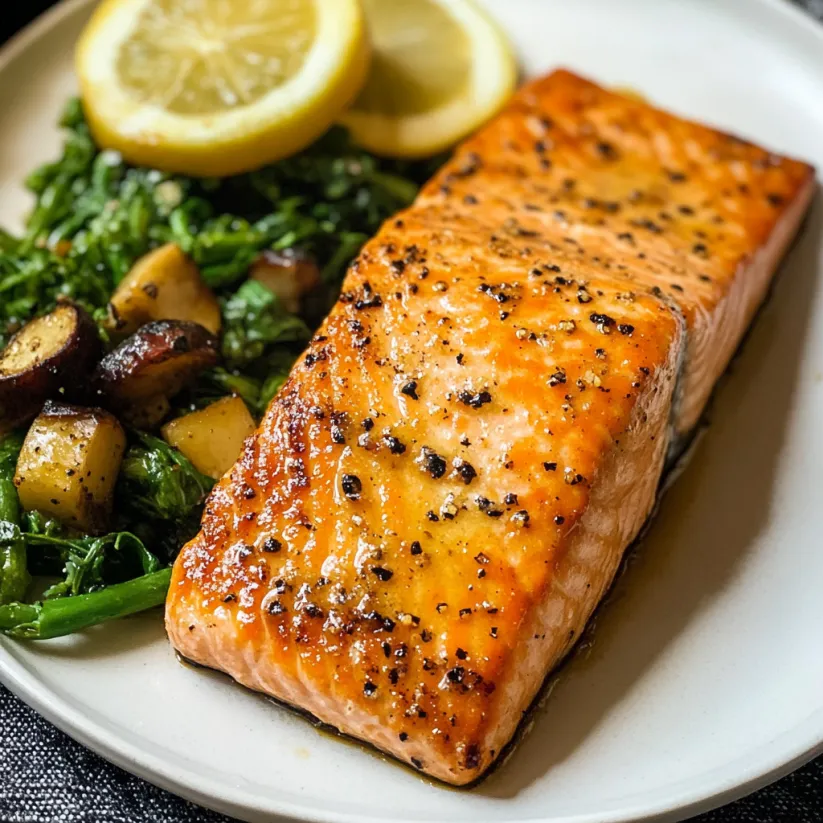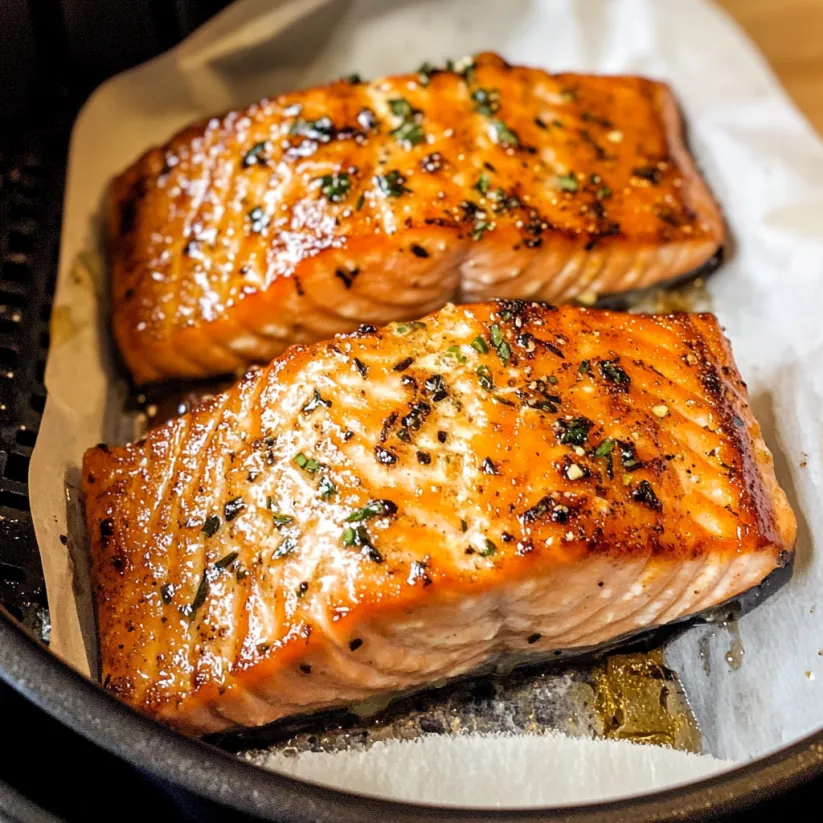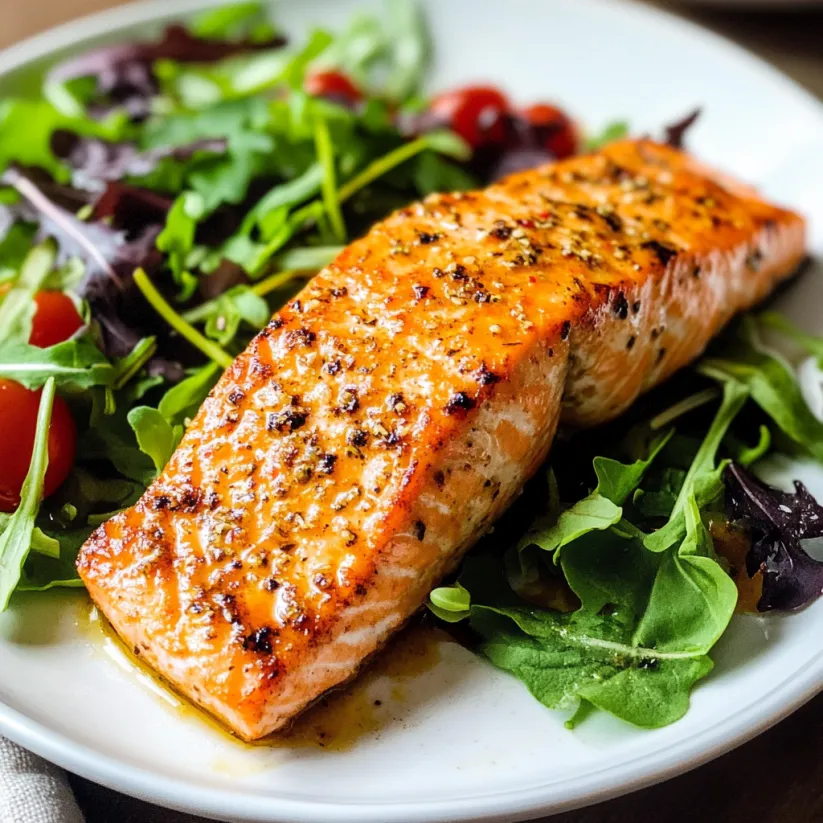 Save Pin
Save Pin
This salmon recipe has transformed my weeknight dinner routine, delivering restaurant-quality fish with minimal effort. The air fryer creates that perfect balance of crispy exterior and tender, flaky interior that's often difficult to achieve with other cooking methods.
I discovered this method during a particularly hectic week when I needed nutritious meals but had zero energy for complicated cooking. Now it's become my most reliable way to impress dinner guests while actually spending more time with them than in the kitchen.
Ingredients
- Salmon fillets about 6 ounces each. Choose center cut pieces with vibrant color and firm texture for best results
- Kosher salt enhances the natural flavors without making the fish taste salty
- Ground black pepper adds a subtle warmth that complements the salmon perfectly
- Brown sugar or honey creates that irresistible caramelization on top
- Dijon mustard provides tangy depth while helping the glaze adhere to the fish
- Extra virgin olive oil adds richness and helps prevent sticking
- Low sodium soy sauce brings umami depth without overpowering the delicate fish
- Garlic powder infuses subtle flavor throughout without the risk of burning fresh garlic
- Ground ginger optional but highly recommended for a gentle warming note
Step-by-Step Instructions
- Prepare the Salmon
- Pat the salmon completely dry with paper towels to ensure crispy results. This step is crucial as moisture is the enemy of that perfect exterior. Season both sides with salt and pepper using a light touch to enhance the natural flavor.
- Create the Easy Cleanup System
- Line your air fryer basket with aluminum foil for virtually no cleanup later. Preheat your air fryer to 400°F which typically takes about 3 minutes but follow your specific model's instructions for best results.
- Mix the Perfect Glaze
- Combine brown sugar or honey with Dijon mustard olive oil soy sauce garlic powder and ginger in a small bowl. Stir until completely smooth to create a balanced sweet tangy sauce that will caramelize beautifully. Spoon this generously over the top of each fillet covering all exposed flesh.
- Position for Optimal Cooking
- Place the prepared fillets in the preheated basket ensuring they don't touch each other. This allows the hot air to circulate properly around each piece creating even cooking and that desirable crisp exterior.
- Monitor Cooking Carefully
- Cook for 6 to 11 minutes depending on thickness. For standard fillets about 1 inch thick aim for 8 to 9 minutes. The key to perfect salmon is cooking just until it reaches 145°F on an instant read thermometer or slightly under since carryover cooking will continue after removal.
- Rest and Serve
- Transfer to serving plates and allow to rest for a minute before serving. This brief rest allows the juices to redistribute throughout the fish ensuring maximum moisture and flavor in every bite.
 Save Pin
Save Pin
My favorite part of this recipe is the glaze that forms on top. I once served this to my brother who claimed to hate fish and watched in amazement as he cleaned his plate and asked for the recipe. The combination of sweet brown sugar and tangy Dijon creates magic with minimal ingredients.
Perfect Pairings
This salmon pairs beautifully with simple roasted vegetables like asparagus or Brussels sprouts which can even be cooked in the air fryer after the salmon is done. The subtle sweetness of the glaze also works wonderfully with grain bowls featuring quinoa or brown rice and a squeeze of fresh lemon juice to brighten everything up.
Troubleshooting Tips
If your salmon skin sticks to the foil despite preheating properly try spraying the foil lightly with nonstick cooking spray before placing the fish. For those who prefer skinless fillets this method works equally well just reduce the cooking time by about 1 minute as the heat penetrates faster without the skin barrier.
Variations To Try
This base recipe welcomes customization. Try adding a teaspoon of maple syrup and a dash of smoked paprika for a woodsy Canadian inspired version. Alternatively replace the soy sauce with teriyaki and add sesame seeds for an Asian twist that pairs beautifully with stir fried vegetables.
 Save Pin
Save Pin
Commonly Asked Questions
- → How do I know when the salmon is done cooking?
Salmon is done when it registers 145°F on an instant-read thermometer. For optimal moisture, you can remove it a few degrees early (around 140°F) and let it rest, as carryover cooking will finish the job. The fish should flake easily with a fork but still be moist in the center. Cooking times vary based on thickness—fillets about 1 inch thick typically need 8-9 minutes at 400°F.
- → Can I use frozen salmon in the air fryer?
For best results, thaw frozen salmon completely before air frying. Pat it dry thoroughly with paper towels to remove excess moisture, which helps achieve that desirable crispy exterior. If you must cook from frozen, add approximately 3-4 minutes to the cooking time, but be aware the texture and evenness of cooking may not be as perfect as with thawed fillets.
- → What can I substitute for the brown sugar or honey?
Maple syrup makes an excellent substitute for brown sugar or honey in this glaze. Other alternatives include coconut sugar, agave nectar, or even a tablespoon of orange marmalade for a citrusy twist. Each will provide the necessary sweetness to balance the savory components, though each imparts a slightly different flavor profile.
- → Is it necessary to preheat the air fryer?
Yes, preheating your air fryer is important for even cooking and achieving that desirable crispy exterior. Most models need about 3 minutes to reach 400°F. Placing salmon in a preheated air fryer ensures it starts cooking immediately at the proper temperature, which helps seal in moisture while creating the perfect texture.
- → What sides pair well with this salmon?
This salmon pairs beautifully with roasted asparagus, brussels sprouts, or broccoli. For a complete meal, serve with quinoa, brown rice, or roasted sweet potatoes. A simple green salad with lemon vinaigrette also makes a refreshing side. For an impressive dinner, pair with garlic green beans and herbed couscous or risotto.
- → Can I make this without soy sauce for a gluten-free version?
Absolutely! Substitute the soy sauce with tamari (gluten-free soy sauce), coconut aminos, or liquid aminos for a gluten-free version that maintains the umami flavor. Coconut aminos are slightly sweeter, so you might want to reduce the brown sugar or honey slightly if using this alternative.
